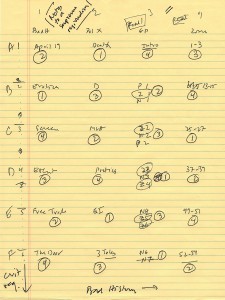Reading @ Nuremberg
Bavarian-American Academy
Stadtbibliothek Nürnberg
7:30 PM, 27 May 2013
For my reading, I took as a model my 1999 presentation at Kelly Writers House, about which Brian Ang wrote perceptively [here]. In that event, I used stanzas from “Non-Events” as my guide, alternating between a regular progress through the poem as semantic and rhythmic baseline, while adding selections from Bad History and prose from The Constructivist Moment. As befit our location in Nuremberg–where instances of “bad history” had been promulgated–I decided to make selections from Bad History the structural baseline for a work to be drawn from four discrepant texts: Bad History, Politics of Nothing (work in progress), The Grand Piano (vol. 9: “Double Negative”), and Zone (work in progress). I wanted a multimodal summoning of the negative, interspersed with the topics dealt with in these works: language and ideology after the Gulf War I; the atrophy of public discourse in the Bush Era; the question of “accounting for oneself” in poetry and criticism; and the unfinished project of democracy realized in a reading through of William Carlos Williams’s Paterson. Those were the materials with which I would summon a common purpose–to negate historicism under conditions of the present, to release criticality like 10 cc of Paris air in the city of Nuremberg, to dismantle all purposefulness and achieve a state of permanent play. In so doing I created a 4 x 6 matrix (four works; six sections each) and used random permutations of four digits (1/2/3/4) to determine their order. The handwritten matrix for the reading is reproduced above, yielding the following sequence of passages that I read. Each passage occurs at the intersection of two axes, labeled “Bad History” and “Critical Regionalism” (after the topic of our conference), and under four headings (Bad H; Pol X; GP; Zone):
A1: “Against Death,” Politics of Nothing, MS
A2: “April 19,” Bad History, 80-83
A3: Zone I, sects. 1-3, MS
A4: “Double Negative,” introduction, Grand Piano 9:148-50
B1: “Erotica,” Bad History, 84-86
B2: “Double Negative,” sect. “Progress” (1), Grand Piano 9:150-53
B3: “Detroit,” Politics of Nothing, MS
B4: Zone I, sects. 13-15, MS
C1: Zone I, sects. 25-27, MS
C2: “MLA Dream,” Politics of Nothing, MS
C3: “Double Negative,” sect. “Negativity” (1), Grand Piano 9:154-56
C4: “Screen Saver,” Bad History, 87-89
D1: “Double Negative,” sect. “Negativity” (2), Grand Piano 9:157-60
D2: Zone 1, sects. 37-39, MS
D3: “Event,” Bad History, 90-94
D4: “Poetics,” Politics of Nothing, MS
E1: “Question of Interpretation,” Politics of Nothing, MS
E2: “Free Trade,” Bad History, 95-97
E3: “Double Negative,” sect. “Negativity” (3), Grand Piano 9:164-67
E4: Zone I, sects. 49-51, MS
F1: “Double Negative,” sect. “Negativity” (6), Grand Piano 9:178-79
F2: Zone I, sects. 52-54, MS
F3: “Three Tales,” Politics of Nothing, MS
F4: “The Door,” Bad History, 98-101
The grid thus began with “April 19” and ended with “The Door”–for both sections, I had recent experiences that added new interpretations. While traveling in Poland, I learned that April 19 was the date of the Warsaw Ghetto Uprising of 1943, to be distinguished from the Warsaw Uprising of 1944 (which Poles call Godzina W, in contrast to the rejected date of liberation, Stunde Null, 8 May 1945). So “April 19” acquired an additional interpretive layer, to join with the Oklahoma City bombing, Branch Davidian massacre, and the personal references in the poem. The occasion of the poem, not to be coy, was the sale of the family home after my mother’s death; she was born on April 19. Traversing the ground of the psychosexual (a recurrent topic at our conference, it turned out, in part due to Jessica Pliley’s research on White Slave traffic and the Mann Act), “The Door” is a rewrite of Robert Creeley’s poem of the same name, in the context of the preceding sections “Erotica” and “Free Trade” (as well as “Screen Saver” and “Event”). Carla Harryman had just collaborated with Jon Raskin and Roham Sheikami on a improvised version of this piece at the Center for New Music in San Francisco. Also, “Event” recalled an exchange with the visiting Americanist Donald Pease, who was in the audience, on the phenomenology of the Event at last year’s conference; he had criticized my account of Stunde Null in what seemed at the time obscure terms (given that the Event has by no means diminished in importance). This time, Pease had several interesting things to say during the Q&A, calling the reading overall a “Notes to a Supreme Regionalism” (see handwriting above) and asking if I saw the dangers of channeling the “uninterrupted poetry” of Charles Olson’s reading at Berkeley. This referred to my prefacing the reading itself with passages I quoted from Terry Eagleton’s Criticism & Ideology in “The Politics of Style,” my piece in our forthcoming Guide to Poetics Journal, applied to Olson’s reading at Berkeley in 1965. The overarching goal of my presentation, if there could be such a thing, was to bring, in Eagleton’s terms, “the signifying process into a certain relief.” That, without the autoerotic excess of Olson’s expansionist self, predicated on imperial assumptions, and we are done. Certain decisions in the reading, of course, were revised or altered during the reading itself.













